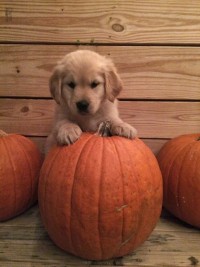
Photo by Megan Barnhart & Amy Justice
So, I have been looking for an excuse to write something that includes our new puppy. (Meet Nala, born 10/6/2014) Once again, Nina Simon (Museum 2.0, among many other things) has come through for me. In reviewing her presentations I was reminded of a question she sometimes asks: “How can we make our art more like dogs?” Her point is that dogs mediate communication. Dogs provide an opportunity (or excuse) for strangers to connect. They are a catalyst for interaction. Ms. Simon asks, quite rightly I think, how can we make our arts experiences more conducive to people talking to each other?
My experience with Nala is that many, many, many people talk to me (er, us) who would otherwise pass me by without a second glance. This tendency to relate crosses many social, racial/ethnic, even class lines. What really brought this home to me is what’s happened on the occasions when I’ve had to take her outside in front of our downtown condo in the wee hours of the morning. I’ve had numerous conversations with people whom I presume to be homeless. With big smiles, they ask me what breed she is, how old she is, and comment on how *big* she is going to get. (I’m choosing not to think about that last one too much.) But seriously, her presence makes it “safe” to talk to me. They sometimes also talk with me about dogs in their own lives.
I (and many others) have written about the capacity of the arts to provide enough distance to allow people to address controversial issues with less raw emotion than is otherwise the case. I think that there is also much that could be done to design arts experiences as opportunities to promote simple non-fraught human connections, bridging gaps between strangers. That is, or should be, a significant element of community engagement. I imagine there is a systematic way of approaching this: how can our work be made more like golden retriever puppies? I’ll try to develop a way of thinking it through sometime, but right now I have to take my dog out.
Engage!
Doug

who doesn’t like puppies? loved this comparison, doug.*** imaginative and insightful but also deeply intellectual!
lillian shelton
Thanks for the post! I have mentioned this concept in class from time to time, but have only been able to find useful corollaries in arts education environments (instrument petting zoos, for example). Regardless — more pictures of Nala as she grows up, please 🙂
Cuteness, adorable, innocence, playful, humorous, animated, possibility, imaginative, vulnerable, loving, dependent… when I think of what around the arts (esp. European classical music) possesses these qualities to facilitate conversations across social divides, I come up with children, esp. youth orchestras and music schools. The classical music industry has been so caught up in maintaining art as lofty, academic and exhalted, that to make it cute and adorable represents the “dumbing down” the industry feared, esp. following the 1993 publication “Americanizing the American Orchestra”. I hope we can begin to step back from this monochromatic paradigm to balance the arts with cute, playful and vulnerable offspring besides our children to re-imagine the classical arts something everyone can melt over.
I think there is wariness about “fun.” To some it implies a lack of seriousness that runs counter to assumptions about “high art.” I’ve suggested in the past the words inspire, delight, and surprise as good options to consider. Maybe two of the three in any one presentation?
I use “fun” not in the sense of “comic”, but in the sense of “joy”. What’s not apparent to the newcomer is the joy we take playing “serious” music.